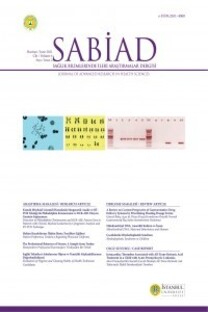YETİŞKİNLERDE ORTOREKSİYA NERVOZA EĞİLİMLERİ İLE BEDEN MEMNUNİYETSİZLİĞİ ARASINDAKİ İLİŞKİNİN DEĞERLENDİRİLMESİ
Ortoreksiya nevroza, beden memnuniyetsizliği, yetişkin
EVALUATING THE RELATIONSHIP BETWEEN TENDENCIES OF ORTHOREXIA NERVOSA AND BODY DISSATISFACTION AMONG ADULTS
Orthorexia nervosa, body dissatisfaction, adult,
___
- Koven NS, Abry AW. The clinical basis of orthorexia nervosa: emerging perspectives. Neuropsychiatr Dis Treat 2015;18(11):385-94. google scholar
- Arusoğlu G, Kabakçi E, Köksal G, Merdol TK. Orthorexia Nervosa and Adaptation of ORTO-11 into Turkish. Turk Psikiyatri Derg 2008;19(3):283-91. google scholar
- Bratman S, Knight D. Health food junkies: overcoming the obsession with healthful eating. New York:Broadway Books; 2000. p.1-242. google scholar
- Cena H, Barthels F, Cuzzolaro M, Bratman S, Brytek-Matera A, Dunn T, et al. Definition and diagnostic criteria for orthorexia nervosa: a narrative review of the literature. Eat Weight Disord 2019;24(2):209-46. google scholar
- He J, Zhao Y, Zhang H, Lin Z. Orthorexia nervosa is associated with positive body image and life satisfaction in Chinese elderly: Evidence for a positive psychology perspective. Int J Eat Disord 2021;54(2):212-21. google scholar
- Baysal I, Kızıltan G. The Determination of the Relationship between Food Neophobia and Orthorexia Nervosa Tendencies and Nutritional Status of Individuals who Engage in Sports. Bes Diy Derg 2020;48(3):48-55. google scholar
- Melzer K, Kayser B, Saris WH, Pichard C. Effects of physical activity on food intake. Clin Nutr 2005;24(6):885-95. google scholar
- American Psychiatric Association. Diagnostic and Statistical Manual of Mental Disorders. 5th ed. Arlington: American Psychiatric Publishing; 2013. google scholar
- Eriksson L, Baigi A, Marklund B, Lindgren E-C. Social physique anxiety and sociocultural attitudes toward appearance impact on orthorexia test in fitness participants. Scand J Med Sci Sports 2008;18(3):389-94. google scholar
- Freire GLM, da Silva Paulo JR, da Silva AA, Batista RPR, Alves JFN, do Nascimento Junior JRA. Body dissatisfaction, addiction to exercise and risk behaviour for eating disorders among exercise practitioners. J Eat Disord 2020;8(1):1-9. google scholar
- Plichta M, Jezewska-Zychowicz M, Gşbski J. Orthorexic tendency in Polish students: exploring association with dietary patterns, body satisfaction and weight. Nutrients 2019;11(1):100. google scholar
- Topçu F, Aricak OT. The Effect of Perfectionism and Body Perception on Orthorexia Among Young Adults. JCBPR 2019;8(3)170-8. google scholar
- Lee RD, David C, editors. Nutritional assessment. New York: McGraw-Hill; 2010. google scholar
- World Health Organization 2020. (cited 2022 July 26). Available from: URL: http://www.euro.who.int/en/health-topics/disease-p revention/nutrition/a-healthy-lifestyle/body-mass-index-bmi. google scholar
- Donini LM, Marsili D, Graziani MP, Imbriale M, Cannella C. Orthorexia nervosa: validation of a diagnosis questionnaire. Eat Weight Disord 2005;10(2):e28-e32. doi: 10.1007/BF03327537 google scholar
- Cooper PJ, Taylor MJ, Cooper Z, Fairbum CG. The development and validation of the Body Shape Questionnaire. Int J Eat Disord 1987;6(4):485-94. google scholar
- Akdemir A, Inandi T, Akbas D, Karaoglan Kahilogullari A, Eren M, Canpolat BI. Validity and reliability of a Turkish version of the Body Shape Questionnaire among female high school students: Preliminary examination. Eur Eat Disord Rev 2012;20(1):e114-e5. doi: 10.1002/erv.1106 google scholar
- Greetfeld M, Hessler-Kaufmann JB, Brandl B, Skurk T, Holzapfel C, Quadflieg N, et al. Orthorexic tendencies in the general population: association with demographic data, psychiatric symptoms, and utilization of mental health services. Eat Weight Disord 2021;26(5):1511-9. google scholar
- Haddad C, Obeid S, Akel M, Honein K, Akiki M, Azar J, et al. Correlates of orthorexia nervosa among a representative sample of the Lebanese population. Eat Weight Disord 2019;24(3):481-93. google scholar
- Brytek-Matera A, Gramaglia C, Gambaro E, Delicato C, Zeppegno P. The psychopathology of body image in orthorexia nervosa. J Psychopathol 2018;24:133-40. google scholar
- Featherstone M. The body in consumer culture. In: Featherstone M, Hepworth M, Turner SB, editors. The Body: Social Process And Cultural Theory. London: Sage Publications; 1991.p.170-97. google scholar
- Bosi ATB, Camur D, Güler C. Prevalence of orthorexia nervosa in resident medical doctors in the faculty of medicine (Ankara, Turkey). Appetite 2007;49(3):661-6. google scholar
- Kapoor A, Upadhyay MK, Saini NK. Prevalence, patterns, and determinants of body image dissatisfaction among female undergraduate students of University of Delhi. J Family Med Prim Care 2022;11(5):2002-7. google scholar
- Cinosi E, Matarazzo I, Marini S, Acciavatti T, Lupi M, Corbo M, et al. Prevalence of orthorexia nervosa in a population of young Italian adults. Eur Psychiatry 2015;30(S1):1330. 25. google scholar
- Sanlier N, Yassibas E, Bilici S, Sahin G, Celik B. Does the rise in eating disorders lead to increasing risk of orthorexia nervosa? Correlations with gender, education, and body mass index. Ecol Food Nutr 2016;55(3):266-78. google scholar
- Brytek-Matera A. Orthorexia nervosa-an eating disorder, obsessive-compulsive disorder or disturbed eating habit. Arch Psychiatry Psychother 2012;1(1):55-60. google scholar
- Swami V, Steadman L, Tovee MJ. A comparison of body size ideals, body dissatisfaction, and media influence between female track athletes, martial artists, and non-athletes. Psychol Sport Exerc 2009;10(6):609-14. google scholar
- Karr TM, Davidson D, Bryant FB, Balague G, Bohnert AM. Sport type and interpersonal and intrapersonal predictors of body dissatisfaction in high school female sport participants. Body Image 2013;10(2):210-9. google scholar Coelho GC, Troglio GM, Hammes L, Galv TD, Cyrino LAR. As consequencias fsicas, ps^quicas e sociais em indivıduos com ortorexia nervosa. RBONE 2016;10(57):160-8. google scholar
- Yayın Aralığı: Yılda 3 Sayı
- Başlangıç: 2018
- Yayıncı: İstanbul Üniversitesi
Ayşe EROL, Figen ABATAY SEL, Mediha SÜLEYMANOĞLU, Gökhan DEMİRAYAK, Dürdane Serap KURUCA, Fatma Savran OĞUZ
POSTERİOR REVERSİBL ENSEFALOPATİ SENDROMU (PRES) HAKKINDA BİLDİKLERİMİZ DOĞRU MU?
Özlem KARABAY AKGÜL, Erhan OKUYAN, Evrim Ebru KOVALAK, Güzide Ece AKINCI, Mehmet Salih SEVDİ, Hakan GÜRASLAN, Nurşen KURTOĞLU AKSOY, Neşe HAYIRLIOĞLU
Arzu MORÇİÇEK, Ali ÇEKİCİ, Vakur OLGAÇ
YETİŞKİN VE PEDİATRİK KANSERLİ HASTALARDA İLERİ BAKIM PLANLAMASI: GÖZDEN GEÇİRME
Yağmur BERKTAŞ, Ülkü Miray YILDIRIM, Rejin KEBUDİ
FARKLI RESTORASYON MATERYALLERİNİN EĞİLME DAYANIMLARININ KARŞILAŞTIRILMASI
Almira Ada DİKEN TÜRKSAYAR, Simge BAYTUR
Sevde GÖKSEL, Ahmet Faruk ERTURK, Gulsevim ODA, Hülya ÇAKIR KARABAŞ, İlknur ÖZCAN
Cennet YILDIZ, Eray YURTSEVEN, Nihan TURHAN, Mehmet Güven GÜNVER
Emre Sertaç BİNGÜL, Emıne Aysu SALVIZ, Mert CANBAZ, Mehmet GÜZEL, Erol KOZANOĞLU, Meltem KARADENİZ
